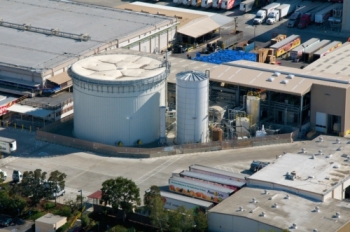May 17 2013
The Kroger Co. today unveiled a clean energy production system that will convert food that can't be sold or donated into clean energy to help power its Ralphs/Food 4 Less Compton distribution center.
 Kroger Unveils A Clean Energy Production System Powered By Food Waste. (PRNewsFoto/Ralphs/Food 4 Less)
Kroger Unveils A Clean Energy Production System Powered By Food Waste. (PRNewsFoto/Ralphs/Food 4 Less)
The anaerobic conversion system will process more than 55,000 tons of organic food waste into renewable energy annually and provide power for the over 650,000 square foot distribution center. By diverting that food waste – the equivalent of 150 tons per day – the system will also reduce area truck trips by more than 500,000 miles each year. The Kroger Recovery System uses a sophisticated process to convert the carbon in organic material into a renewable source of methane.
"We are committed to finding solutions for food waste and clean energy, and we believe this is a meaningful step forward," said Rodney McMullen , President and COO, The Kroger Co. "Investing in this project is a good business decision for Kroger and, most importantly, an extraordinary opportunity to benefit the environment. We want to thank Governor Brown and his team at CalRecycle and CalEPA, the City of Compton, the SCAQMD, and most importantly the team at FEED for making this renewable energy project a reality."
How it works
The Kroger Recovery System utilizes anaerobic digestion, a naturally occurring process, to transform unsold organics and onsite food-processing effluent into renewable biogas. This biogas is then turned into power for onsite operations. The process is carried out in an enclosed, oxygen-free environment, which means the process takes up less space and generates no odors. The system will provide enough renewable biogas to offset more than 20% of the energy demand of the Ralphs/Food 4 Less distribution center. Combining the use of renewable energy power with more than 150 zero emission fuel cell fork lifts, the Ralphs/Food4Less distribution center is now one of the greenest and most efficient, advancing the City of Compton as a leading sustainable community.